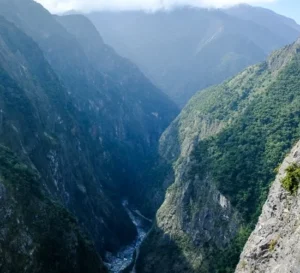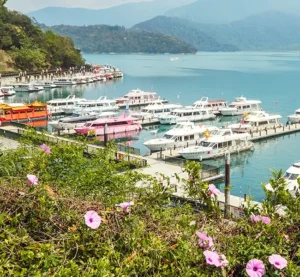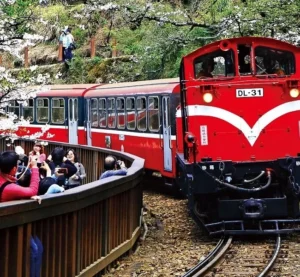Taiwan
UTC+8 (National Standard Time)
No daylight saving time observed
New Taiwan Dollar (TWD)
Symbol: NT$ or NT
Credit cards widely accepted in urban areas
October 10 (Double Ten Day)
Commemorates the Wuchang Uprising of 1911
Major celebration with parades and events
Visa-free entry for many countries (14-90 days)
E-visa available for eligible nationalities
Visa-exempt entry requires a passport valid for 6 months
Culture
Taiwan's culture is a fascinating blend of traditional Chinese influences, indigenous heritage, Japanese colonial legacies, and modern global elements. This unique cultural mix has evolved through centuries of history, migration, foreign rule, and economic development, creating a distinctive Taiwanese identity.
Key elements of Taiwanese culture include:
- Linguistic diversity: While Mandarin Chinese is the official language, many Taiwanese also speak Taiwanese Hokkien (Minnan) and Hakka dialects. There are also several indigenous languages spoken by Taiwan's aboriginal peoples, who comprise about 2.3% of the population and have their own distinct cultural traditions.
- Religious practices: Taiwan has remarkable religious diversity and tolerance, with Buddhism, Taoism, folk religion, Christianity, and Islam coexisting peacefully. Temples are central to community life, and religious festivals like the Mazu pilgrimage (honoring the sea goddess) attract millions of participants.
- Traditional arts: Taiwanese culture preserves many traditional Chinese art forms including calligraphy, painting, paper cutting, and crafts like ceramics and lacquerware. The National Palace Museum in Taipei houses one of the world's largest collections of Chinese art and artifacts.
- Performance arts: Traditional Chinese opera forms, puppetry (particularly glove puppetry or budaixi), and indigenous dance are important cultural expressions. Modern Taiwanese pop music, cinema, and television dramas are also influential throughout Asia.
- Tea culture: Tea drinking is deeply embedded in daily life, with Taiwan producing world-renowned oolong teas, particularly from the high mountain regions. Tea houses are social hubs where people gather to enjoy fine teas in traditional ceremonies.
Taiwan's vibrant night market culture is famous throughout Asia, with hundreds of markets across the island offering local delicacies, games, shopping, and entertainment. These bustling markets are the heart of Taiwanese social life and food culture.
Taiwanese cuisine is acclaimed for its variety, flavor, and creativity:
- Xiaochi (small eats): Taiwan is famous for its street food culture, with signature dishes like stinky tofu, oyster omelette, beef noodle soup, and bubble milk tea (which originated in Taiwan)
- Regional specialties: Each region has distinctive dishes, such as Tainan's coffin bread, Taichung's sun cakes, and Taipei's mango shaved ice
- Seafood: Being an island, Taiwan excels in seafood dishes, particularly in coastal areas like Keelung and Penghu
- Aboriginal cuisine: Indigenous culinary traditions feature unique cooking methods like stone grilling and ingredients such as millet, wild vegetables, and game
- Modern innovations: Taiwan's culinary scene continuously evolves, with creative chefs blending traditional techniques with contemporary presentations
While maintaining strong cultural ties to Chinese traditions, Taiwan has developed a distinct identity shaped by its democratic values, technological innovation, and openness to global influences. This is reflected in its thriving creative industries, progressive social policies, and the value placed on education and innovation.
Tourism & Best Sites to Visit
Taiwan offers extraordinary diversity for travelers, from modern cities and ancient temples to dramatic mountains and pristine beaches. Despite its compact size (about 36,000 km²), the island packs remarkable variety into its landscapes, architecture, and experiences.
Here are some of Taiwan's most impressive destinations:





Taipei 101: Once the world's tallest building (2004-2010), this iconic 101-story skyscraper defines Taipei's skyline. The design incorporates traditional Chinese elements and cutting-edge engineering, including a massive tuned mass damper visible from the observation deck. The tower houses shopping, dining, offices, and offers spectacular views across the city to the surrounding mountains.
Taroko Gorge: One of East Asia's most spectacular natural wonders, this 19-km marble canyon features towering cliffs, crystal-clear rivers, and numerous hiking trails. The Taroko National Park encompasses diverse ecosystems from subtropical forests to alpine environments. The historic Swallow Grotto trail and Eternal Spring Shrine are particularly popular spots within the gorge.
Sun Moon Lake: Taiwan's largest alpine lake is named for its shape – one side resembling a sun, the other a crescent moon. Surrounded by forested mountains and temples, the lake offers boating, cycling (on a scenic 30-km path circling the shore), and cultural experiences in nearby aboriginal villages. The Ci-en Pagoda provides panoramic lake views.
Jiufen Old Street: This atmospheric former gold mining town cascades down a mountainside overlooking the northeast coast. Its narrow lanes, red lanterns, tea houses, and sea views allegedly inspired the setting for the animated film "Spirited Away." The A-Mei Tea House and crowded food stalls create a magical ambiance, particularly as dusk falls.
Alishan Forest Railway: One of only three mountain railways in the world, this narrow-gauge line climbs from tropical lowlands to misty cypress forests at 2,200 meters elevation. The century-old trains are renowned for their "sea of clouds" views and sunrise watches. The surrounding Alishan National Scenic Area offers cherry blossoms in spring and ancient trees over 2,000 years old.
Other remarkable destinations include the National Palace Museum with its imperial Chinese treasures; Kenting National Park with its tropical beaches and coral reefs; Tainan's historic temples as Taiwan's oldest city; Yangmingshan National Park with its volcanic features and hot springs; and Penghu Islands with their basalt columns and pristine beaches.
Transportation
Taiwan boasts one of Asia's most efficient, affordable, and user-friendly transportation systems. The comprehensive network allows visitors to explore the island with ease, whether navigating urban centers or reaching remote natural attractions.
- High-Speed Rail (HSR): The Taiwan High Speed Rail connects the western corridor from Taipei to Kaohsiung in as little as 1.5 hours, with trains reaching speeds of 300 km/h. The system is renowned for its punctuality, comfort, and efficiency. Stations are typically located outside city centers but connect to local transport networks. Advance reservations are recommended, especially during holidays.
- Traditional Railways (TRA): Taiwan Railways Administration operates a comprehensive network reaching most towns and cities, including the scenic East Coast line with spectacular ocean views. While slower than HSR, these trains offer more stations and lower fares. The Alishan Forest Railway and Pingxi Line provide special tourist experiences through mountainous terrain.
- Metro Systems: Taipei and Kaohsiung have excellent MRT (Mass Rapid Transit) systems that are clean, affordable, and easy to navigate with English signage. Taichung's MRT system is newer and expanding. The Taipei MRT connects to numerous attractions, shopping districts, and suburban areas, making it ideal for city exploration.
- Buses: An extensive network of city and intercity buses reaches virtually every corner of Taiwan. Highway buses connect major cities, while local routes serve smaller towns and rural areas. The system can be complex for visitors, but major routes have English information, and Taiwan's transportation apps provide guidance.
- YouBike: Taiwan's popular bike-sharing system operates in major cities, offering an eco-friendly way to explore urban areas. Taipei's riverside bike paths and dedicated cycling lanes make this a pleasant option. Taiwan is also a premier destination for cycling enthusiasts, with the round-island route being especially popular.
- Taxis and Ride-Hailing: Taxis are plentiful in urban areas, with metered fares and generally honest drivers. Many don't speak English, so having destinations written in Chinese is helpful. Taxi apps like Taiwan Taxi and international platforms like Uber operate in major cities.
Transportation Cards: The EasyCard (悠遊卡) is an essential tool for visitors, providing convenient payment for MRT, buses, trains, convenience stores, and many attractions. It eliminates the need to purchase individual tickets and often provides discounted fares. Similar cards include iPASS and iCash, though EasyCard has the most comprehensive coverage.
Transportation Apps: Several apps make navigating Taiwan simpler:
- Taiwan Railway (台鐵e訂通) for train schedules and bookings
- Bus+ for real-time bus tracking
- Google Maps works well for public transit routing
- Taipei MRT and other city-specific metro apps
Accessibility: Taiwan's public transportation system is increasingly accessible, with most MRT stations equipped with elevators and tactile flooring. Many buses offer low-floor access for wheelchairs and strollers. The Taiwan Tourist Shuttle network connects major attractions with regular bus services designed for visitors.
Car and Scooter Rental: For exploring remote areas, car rental is available to those with an International Driving Permit. Scooters are ubiquitous in Taiwan and can be rented, though this requires a local license and proper experience due to sometimes chaotic traffic conditions.
Airports
Taiwan is served by several international and domestic airports, providing excellent connectivity both internationally and between different parts of the island.
- Taiwan Taoyuan International Airport (TPE): Located about 40 km west of Taipei, this is Taiwan's primary international gateway handling over 45 million passengers annually. The modern facility has two terminals with a third under construction, hosting flights to destinations throughout Asia, North America, Europe, and Oceania. Taiwan's main carrier, China Airlines, and EVA Air both use TPE as their hub. The airport offers extensive shopping, dining, and services, including free Wi-Fi, shower facilities, and transit hotels.
- Taipei Songshan Airport (TSA): Located in downtown Taipei, this smaller airport handles domestic flights and some international routes to nearby Asian destinations, particularly Tokyo Haneda, Seoul Gimpo, and several cities in mainland China. Its convenient location makes it popular for business travelers.
- Kaohsiung International Airport (KHH): Serving southern Taiwan, Kaohsiung's airport offers international connections to various Asian cities and extensive domestic services. Its location close to downtown Kaohsiung makes it convenient for travelers visiting the southern regions.
- Taichung International Airport (RMQ): Central Taiwan's main airport offers flights to various Asian destinations and domestic routes. It provides a convenient alternative for accessing the central regions of Taiwan.
- Other regional airports: Taiwan maintains several smaller airports including Hualien, Taitung, Penghu, and Kinmen, which mainly serve domestic routes and are crucial for connecting outlying islands to the main island.
Airport Transportation: Options for reaching your destination from Taiwan's airports include:
- Taoyuan Airport MRT: A dedicated rail line connects Taoyuan Airport to Taipei Main Station in approximately 35 minutes, offering both express and local services. This is the most convenient option for reaching Taipei city center.
- Airport buses: Multiple companies operate frequent bus services from Taoyuan Airport to various destinations in Taipei and other cities. These are often cheaper than the MRT but take longer due to potential traffic.
- High Speed Rail connection: Taoyuan Airport is connected to the HSR network, allowing direct access to cities along Taiwan's western corridor without needing to go through Taipei.
- Taxis: Available at all airports with regulated fares. From Taoyuan to Taipei, expect to pay approximately NT$1,000-1,200 (US$33-40), more during late night hours.
- Car rental: Major international and local rental companies have counters at the airports. An International Driving Permit is required.
Immigration and Customs: Taiwan's entry procedures are generally efficient with automated gates available for eligible travelers enrolled in advance. Most visitors receive an entry stamp valid for their visa-free period. Customs regulations are standard, with restrictions on bringing in food products, particularly those containing meat.
Visa & Travel Information
Taiwan offers relatively straightforward visa policies for tourists and business travelers, with many nationalities eligible for visa-free entry.
Visa Requirements by Nationality
The following table outlines entry requirements for common nationalities:
| Nationality | Entry Option | Maximum Stay |
|---|---|---|
| USA, Canada, UK, EU, Australia, New Zealand | Visa-Free | 90 days |
| Japan, South Korea | Visa-Free | 90 days |
| Malaysia, Singapore | Visa-Free | 30 days |
| Thailand, Philippines | Visa-Free | 14-30 days (varies) |
| India, Vietnam, Indonesia | Visa Required | Depends on visa type |
Visa-Free Entry Requirements: For eligible nationalities, requirements typically include:
- Passport valid for at least 6 months beyond the intended period of stay
- Confirmed return or onward tickets
- Proof of accommodation arrangements
- No criminal record
- Entry through designated international airports/seaports
E-Visa Program: For nationalities not eligible for visa-free entry, Taiwan offers an e-visa program for tourism, business, and other short-term purposes. Applications are submitted online, typically processed within 3 business days, and require supporting documentation including invitation letters for business visits.
Important Travel Considerations
- Health and insurance: Taiwan has excellent healthcare facilities, but medical care for foreigners can be expensive. Comprehensive travel insurance is highly recommended. No specific vaccinations are required for entry unless arriving from areas with yellow fever.
- Currency and payments: The New Taiwan Dollar (NT$) is the official currency. ATMs are widely available in urban areas, and major credit cards are accepted at most establishments. However, smaller vendors, night markets, and rural areas may require cash. Many stores and restaurants also accept mobile payment systems like Line Pay.
- Communications: Taiwan has excellent telecommunications infrastructure with affordable prepaid SIM cards available at airports and convenience stores. Free Wi-Fi hotspots are available throughout cities under the iTaiwan network (registration required).
- Safety: Taiwan consistently ranks among the safest destinations in the world with low crime rates. Natural disasters like typhoons (June-October) and earthquakes do occur, so it's advisable to follow official guidance during such events.
Best time to visit: Taiwan has a subtropical climate with distinct seasons:
- Spring (March-May): Pleasant temperatures and cherry blossoms make this a popular time to visit, though spring showers are common
- Summer (June-August): Hot and humid, with occasional typhoons. Mountain areas provide relief from the heat
- Autumn (September-November): Generally considered the most comfortable season with clear skies and moderate temperatures
- Winter (December-February): Mild in the lowlands (average 15-20°C) but cold in the mountains, where occasional snow attracts visitors
Cultural etiquette: Taiwan is generally relaxed regarding etiquette, but some traditional customs are appreciated:
- Remove shoes when entering someone's home
- Avoid writing someone's name in red ink (associated with death)
- When dining, it's polite to leave a small amount of food (finishing everything can suggest you weren't served enough)
- Respect temple etiquette, including modest dress and proper behavior during worship
- Business cards should be exchanged with both hands and received with a slight bow